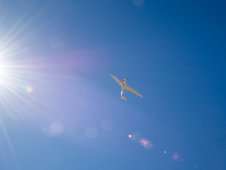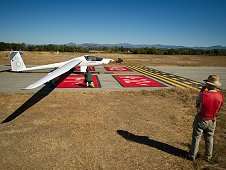Like birds in the sky: Green flight challenge competition, day two

On the second day of the CAFE Green Flight Challenge, sponsored by Google, planes competing in the challenge flew like birds in the sky to test the fuel efficiency of their aircraft.
Day Two of the competition was another fine day in Santa Rosa, Calif., for the Green Flight Challenge, one event in NASA's Centennial Challenges program. Weather was cool in the morning but quickly warmed into the mid 80s with clear blue skies and a few wispy clouds floating in a slight breeze.
The morning kicked off at 11 a.m. EDT with the daily briefing for the competitors, CAFE volunteers and journalists. Today the teams would be flying the fuel efficiency phase of the competition. Teams were required to fly four cycles of the closed loop course with an average speed of at least 100 mph, all while using the energy equivalent of less than one gallon of gasoline per passenger. Total miles to be covered would be about 200 miles.
During the daily briefing there were many technical questions from the team pilots regarding the flight path requirements. CAFE reiterated the minimum -- 4,000 feet -- and maximum -- 6,500 feet -- altitude requirements, staying within two miles of the course flightline and making course turns at the pylons within one-quarter mile. The concern and attention to these details said a lot about the seriousness of the teams to have a clean flight and score points toward the $1.6M prize purse, provided by NASA.
The planes were towed out of the CAFE campus at about 1 p.m. EDT. From lead to last, the order and times of roll-out were:
• The e-Genius, e-Genius team, 1:20 p.m. EDT
• The Taurus G4, Pipistrel USA.com team, 1:25 p.m. EDT
• The PhoEnix, Phoenix Air team, 1:25 p.m. EDT
• The EcoEagle, Embry-Riddle Aeronautical University team, 1:45 p.m. EDT
The planes proceeded to the course circuit and made their first, second and third passes back over the airport at about 30-minute intervals. Each aircraft made a low pass over the CAFE hanger on their final loop to stop the clock on their flight run.
But the day was not without drama...
e-Genius completed the course in a little under two hours and was the first to land, followed shortly by Pipistrel USA.com. Then it was time to watch for the PhoEnix -- but the two-hour mark passed, and still no sighting. Why was it late? Was there a problem?

As the minutes ticked away, questions and tension mounted. Word came that an aircraft had been sighted on final approach to the finish line. As it got closer, all were surprised to see it was the EcoEagle! It had passed the PhoEnix in flight and finished just over the two-hour mark.
The question now in everyone's mind: where was the PhoEnix?
Then over the blue horizon, an aircraft floated into view -- it was the PhoEnix, on its final approach! The PhoEnix team passed the finish line after about 2:30 hours in the air.
Everyone was happy that all four planes were now safely back and they were all greeted with loud applause as they were towed back to the CAFE campus. The pilots were debriefed, the planes inspected and flight data was retrieved from the onboard recorders. The planes were later rolled into position to start their recharging cycle that will continue over night and into Wednesday.
Teams will be taking it a bit easy on Wednesday. They will be analyzing their data. and planning their strategy for the speed flight competition on Thursday.
Provided by JPL/NASA




















